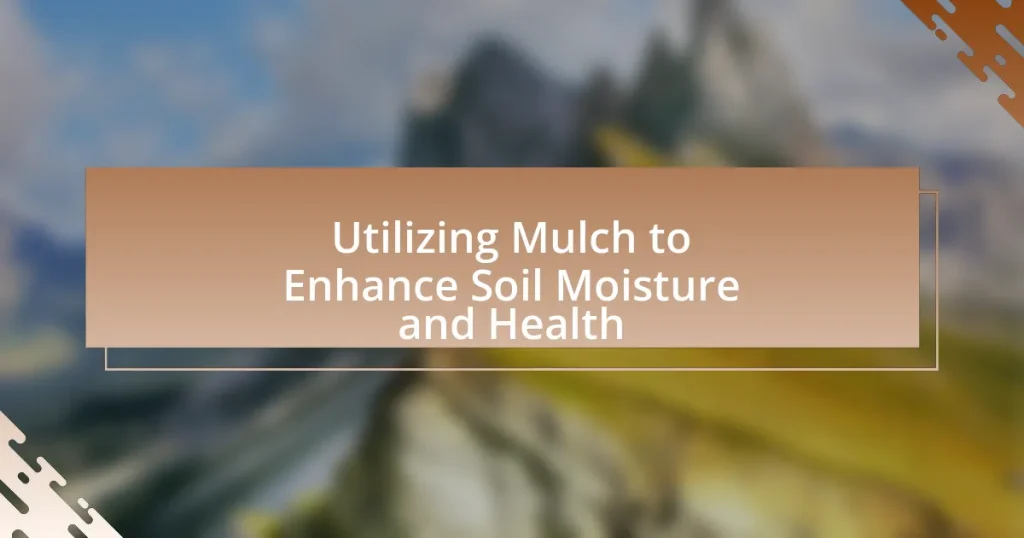Mulch is a critical component in enhancing soil moisture and health, serving multiple functions such as moisture conservation, weed suppression, and soil structure improvement. The article explores the various types of mulch, including organic options like wood chips and straw, and inorganic materials such as gravel and plastic, detailing their specific benefits and applications. It emphasizes the importance of mulch thickness for moisture retention, the role of healthy soil in plant growth, and best practices for effective mulching in different gardening scenarios. Additionally, the article highlights the environmental impacts of using organic mulch and provides practical tips for maintaining mulch over time to ensure optimal soil conditions.

What is Mulch and Its Role in Soil Health?
Mulch is a layer of material applied to the surface of soil, primarily to conserve moisture, suppress weeds, and improve soil health. Its role in soil health includes enhancing soil structure, promoting beneficial microbial activity, and preventing erosion. Research indicates that organic mulches, such as wood chips or straw, decompose over time, adding nutrients back into the soil and improving its fertility. Additionally, studies show that mulching can reduce soil temperature fluctuations, which helps maintain a stable environment for plant roots and microorganisms, ultimately leading to healthier soil ecosystems.
How does mulch contribute to soil moisture retention?
Mulch contributes to soil moisture retention by creating a barrier that reduces evaporation from the soil surface. This layer of organic or inorganic material insulates the soil, maintaining cooler temperatures and preventing moisture loss. Studies have shown that mulched areas can retain up to 50% more moisture compared to bare soil, significantly benefiting plant health and growth.
What types of mulch are most effective for moisture retention?
Organic mulches, such as wood chips, straw, and shredded leaves, are most effective for moisture retention. These materials create a barrier that reduces evaporation from the soil surface, helping to maintain soil moisture levels. Studies have shown that organic mulches can reduce soil temperature fluctuations and improve water infiltration, further enhancing moisture retention. For instance, a study published in the Journal of Soil and Water Conservation found that wood chip mulch reduced soil moisture loss by up to 50% compared to bare soil.
How does the thickness of mulch affect moisture levels?
The thickness of mulch significantly affects moisture levels in the soil. Thicker layers of mulch provide better insulation and reduce evaporation, thereby maintaining higher moisture levels in the soil beneath. Research indicates that a mulch thickness of 2 to 4 inches can effectively retain soil moisture by minimizing direct sunlight exposure and reducing temperature fluctuations. Studies have shown that areas with thicker mulch layers can retain up to 50% more moisture compared to bare soil or thinner mulch applications, demonstrating the critical role of mulch thickness in moisture conservation.
Why is soil health important for plant growth?
Soil health is crucial for plant growth because it directly influences nutrient availability, water retention, and microbial activity. Healthy soil contains a balanced composition of organic matter, minerals, and microorganisms that support plant roots and enhance their ability to absorb essential nutrients. Research indicates that well-structured soil can improve water infiltration and retention, which is vital for sustaining plant life, especially during dry periods. Additionally, healthy soil fosters a diverse microbial community that aids in decomposing organic matter, releasing nutrients in forms that plants can readily utilize. This relationship between soil health and plant growth is supported by studies showing that crops grown in healthy soils yield significantly more than those in degraded soils, highlighting the importance of maintaining soil quality for optimal agricultural productivity.
What are the key indicators of healthy soil?
Key indicators of healthy soil include high organic matter content, good soil structure, adequate moisture retention, and a diverse microbial community. Healthy soil typically contains at least 3-5% organic matter, which enhances nutrient availability and water retention. Soil structure should be crumbly and well-aerated, allowing for root penetration and water movement. Additionally, healthy soil retains moisture effectively, which can be assessed through its ability to hold water without becoming waterlogged. A diverse microbial community, including bacteria, fungi, and other organisms, indicates biological activity that supports nutrient cycling and plant health. These indicators collectively contribute to soil fertility and ecosystem resilience.
How does mulch improve soil structure and fertility?
Mulch improves soil structure and fertility by enhancing moisture retention, reducing erosion, and promoting beneficial microbial activity. When applied to the soil surface, mulch acts as a barrier that minimizes evaporation, allowing the soil to maintain moisture levels essential for plant growth. Additionally, organic mulches decompose over time, adding nutrients such as nitrogen and carbon to the soil, which enriches its fertility. Research indicates that mulching can increase soil organic matter by up to 30% over several years, significantly improving soil structure and nutrient availability.

What are the Different Types of Mulch Available?
There are several types of mulch available, including organic and inorganic options. Organic mulches, such as wood chips, straw, grass clippings, and shredded leaves, decompose over time, enriching the soil with nutrients. Inorganic mulches, like gravel, plastic, and landscape fabric, do not decompose and primarily serve to suppress weeds and retain moisture. Research indicates that organic mulches can improve soil structure and fertility, while inorganic mulches are effective for long-term weed control and moisture retention.
What are organic mulches and their benefits?
Organic mulches are natural materials, such as wood chips, straw, grass clippings, and leaves, used to cover the soil surface. These mulches provide several benefits, including moisture retention, temperature regulation, weed suppression, and improved soil health through the addition of organic matter as they decompose. Research indicates that organic mulches can reduce soil temperature fluctuations by up to 10 degrees Fahrenheit, enhancing plant growth conditions. Additionally, studies show that mulching can decrease weed growth by 80% or more, allowing for better nutrient availability for desired plants.
How do wood chips, straw, and grass clippings differ in use?
Wood chips, straw, and grass clippings differ significantly in their uses as mulch. Wood chips are primarily used for long-term weed suppression and moisture retention due to their slow decomposition rate, making them ideal for pathways and around trees. Straw, on the other hand, is often utilized for short-term soil coverage, providing insulation and moisture retention while decomposing quickly, which is beneficial for vegetable gardens. Grass clippings serve as a nitrogen-rich mulch that decomposes rapidly, enhancing soil fertility but requiring careful application to avoid matting and odor issues. Each material’s unique properties dictate its specific application in enhancing soil moisture and health.
What are the environmental impacts of using organic mulch?
Using organic mulch has several positive environmental impacts, including improved soil health, enhanced moisture retention, and reduced weed growth. Organic mulch, such as wood chips or straw, decomposes over time, enriching the soil with nutrients and promoting beneficial microbial activity. Research indicates that organic mulch can increase soil moisture retention by up to 50%, which is crucial for plant health and reduces the need for irrigation. Additionally, the application of organic mulch can suppress weed growth by blocking sunlight, thereby minimizing the need for chemical herbicides. These benefits contribute to sustainable agricultural practices and promote biodiversity in ecosystems.
What are inorganic mulches and when should they be used?
Inorganic mulches are non-biodegradable materials used to cover the soil surface, such as gravel, stones, plastic, or landscape fabric. These mulches should be used in situations where moisture retention, weed suppression, and soil temperature regulation are desired without the need for organic decomposition, making them ideal for areas with low organic matter or in landscaping where aesthetics and durability are important. For example, plastic mulch can be particularly effective in vegetable gardens to warm the soil and control weeds, while gravel is often used in xeriscaping to reduce water evaporation.
How do landscape fabric and gravel compare to organic options?
Landscape fabric and gravel provide a more durable and low-maintenance alternative to organic options like wood chips or straw. While organic mulches decompose over time, enriching the soil and improving moisture retention, landscape fabric and gravel do not break down, thus requiring less frequent replacement. However, organic options enhance soil health by adding nutrients as they decompose, which is a significant advantage over the inert nature of landscape fabric and gravel. Studies indicate that organic mulches can improve soil structure and microbial activity, contributing to better plant growth compared to the physical barrier created by landscape fabric and gravel.
What are the pros and cons of using inorganic mulch?
Inorganic mulch offers several advantages and disadvantages. The primary benefits include long-lasting durability, effective weed suppression, and minimal maintenance requirements. For instance, materials like gravel or rubber can last for years without decomposing, which reduces the need for frequent replacement. Additionally, inorganic mulch can prevent weed growth by blocking sunlight, thus conserving soil moisture and improving plant health.
Conversely, the drawbacks of inorganic mulch include poor insulation properties and potential heat retention. Unlike organic mulch, which can improve soil structure as it decomposes, inorganic options do not contribute nutrients to the soil. Furthermore, certain inorganic materials can absorb and retain heat, potentially leading to overheating of the soil and harming plant roots.

How Can Mulch Be Effectively Applied in Gardens?
Mulch can be effectively applied in gardens by spreading a layer of organic or inorganic material around plants to retain soil moisture, suppress weeds, and improve soil health. The ideal application involves a thickness of 2 to 4 inches, ensuring that the mulch does not touch plant stems to prevent rot. Research indicates that organic mulches, such as wood chips or straw, decompose over time, enriching the soil with nutrients, while inorganic options, like gravel or rubber, provide long-lasting coverage without decomposition. Properly applied mulch can reduce soil temperature fluctuations and enhance moisture retention, leading to healthier plants and improved garden productivity.
What are the best practices for applying mulch?
The best practices for applying mulch include selecting the right type of mulch, applying it at the correct depth, and ensuring proper placement around plants. Organic mulches, such as wood chips or straw, improve soil health as they decompose, while inorganic options, like gravel, provide long-lasting coverage. A depth of 2 to 4 inches is recommended to suppress weeds and retain moisture without suffocating plant roots. Mulch should be kept a few inches away from plant stems to prevent rot and allow for air circulation. These practices enhance soil moisture retention and promote healthier plant growth, as supported by studies indicating that mulched areas retain significantly more moisture compared to unmulched areas.
How deep should mulch be applied for optimal results?
Mulch should be applied at a depth of 2 to 4 inches for optimal results. This depth effectively suppresses weeds, retains soil moisture, and regulates soil temperature. Research indicates that a 3-inch layer of mulch can reduce soil evaporation by up to 50%, thereby enhancing moisture retention and promoting healthier soil conditions.
What are the common mistakes to avoid when mulching?
Common mistakes to avoid when mulching include applying too much mulch, which can suffocate plants and lead to root rot, and using inappropriate materials, such as fresh grass clippings that can create a mat and prevent water penetration. Additionally, failing to leave space around plant stems can cause moisture buildup and promote disease. Not replenishing mulch regularly can also lead to reduced effectiveness over time. These practices are supported by horticultural guidelines that emphasize proper mulching techniques for optimal plant health and soil moisture retention.
How can mulch be used in different gardening scenarios?
Mulch can be used in various gardening scenarios to improve soil moisture retention, suppress weeds, and enhance soil health. In vegetable gardens, organic mulch such as straw or wood chips helps retain moisture and regulate soil temperature, which is crucial for plant growth. In flower beds, mulch prevents weed growth and reduces competition for nutrients, allowing flowers to thrive. For trees and shrubs, applying mulch around the base conserves moisture and protects roots from temperature extremes. Research indicates that mulching can reduce soil evaporation by up to 70%, demonstrating its effectiveness in maintaining soil moisture levels.
What are the specific benefits of mulch in vegetable gardens?
Mulch provides several specific benefits in vegetable gardens, including moisture retention, temperature regulation, weed suppression, and soil health improvement. By covering the soil, mulch reduces evaporation, helping to maintain consistent moisture levels, which is crucial for vegetable growth. Additionally, mulch acts as an insulating layer, keeping soil temperatures stable, which can enhance seed germination and plant development. Furthermore, mulch suppresses weed growth by blocking sunlight, reducing competition for nutrients and water. Organic mulches, such as straw or wood chips, also contribute to soil health by decomposing and adding organic matter, which improves soil structure and fertility.
How does mulch support flower beds and ornamental gardens?
Mulch supports flower beds and ornamental gardens by retaining soil moisture, suppressing weeds, and improving soil health. By covering the soil, mulch reduces evaporation, ensuring that plants receive adequate water, which is crucial for their growth and vitality. Additionally, mulch acts as a barrier against weed growth, minimizing competition for nutrients and water. Organic mulches, such as wood chips or straw, decompose over time, enriching the soil with nutrients and enhancing its structure, which promotes better root development and overall plant health. Studies have shown that gardens with mulch can retain up to 50% more moisture compared to unmulched areas, demonstrating its effectiveness in maintaining optimal growing conditions.
What are some practical tips for maintaining mulch over time?
To maintain mulch over time, regularly replenish it to a depth of 2-4 inches, as this helps retain moisture and suppress weeds. Additionally, monitor the mulch for decomposition; organic mulches typically break down within a year, necessitating replacement. It is also important to keep mulch away from plant stems to prevent rot and ensure proper air circulation. Lastly, check for any weed growth periodically and remove them to maintain the effectiveness of the mulch layer. These practices are essential for enhancing soil moisture and health, as they promote a stable environment for plant growth.










